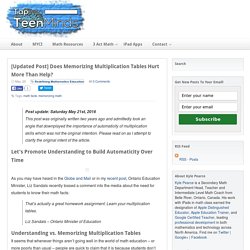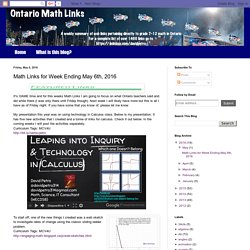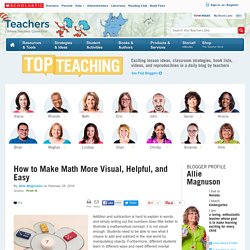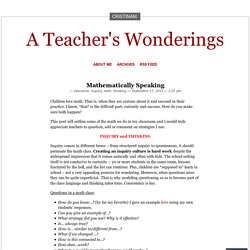

How A Strengths-Based Approach to Math Redefines Who Is “Smart” A group of young women who had graduated from high school between 1997 and 2006 sat at the front of the room crying and laughing about their experiences learning math at Railside High (a research pseudonym for the school).

This session of the National Council of Teachers of Mathematics annual meeting didn’t focus on any specific mathematical practice and yet it was enlightening — with the right approach, teachers can help kids who hate math feel like it’s their best subject. One after another, these young women, who had all graduated from an urban high school serving many kids living in poverty, described how math class made them feel safe, heard and able to express their ideas without fear. “I felt like they cared for me,” said Martha Hernandez, who graduated in 2002 and is now a social worker. Does Memorizing Multiplication Tables Hurt More Than Help? Post update: Saturday May 21st, 2016 This post was originally written two years ago and admittedly took an angle that downplayed the importance of automaticity of multiplication skills which was not the original intention.

Please read on as I attempt to clarify the original intent of the article. Let’s Promote Understanding to Build Automaticity Over Time As you may have heard in the Globe and Mail or in my recent post, Ontario Education Minister, Liz Sandals recently tossed a comment into the media about the need for students to know their math facts: That’s actually a great homework assignment: Learn your multiplication tables.Liz Sandals – Ontario Minister of Education Understanding vs.
Smart Boarding School. Daily Skyscrapers. Math Links for Week Ending May 6th, 2016. It's OAME time and for this weeks Math Links I am going to focus on what Ontario teachers said and did while there (I was only there until Friday though).

Next week I will likely have more but this is all I have as of Friday night. If you have some that you know of, please let me know My presentation this year was on using technology in Calculus class. Ontario Math Resources. Big ideas draft. Illuminations. Tcm2016 03 412a. Great couple of days w awesome staff @ChippewaTVDSB explored Number Talks, Number Relationships & how they connect! How to Make Math More Visual, Helpful, and Easy. Addition and subtraction is hard to explain in words, and simply writing out the numbers does little better to illustrate a mathematical concept: it is not visual enough.

Students need to be able to see what it means to add and subtract in the real world by manipulating objects. Furthermore, different students learn in different ways and need different mental strategies. Including plenty of variety and number arrangements in your math lessons will give you the best chance to help every child achieve addition and subtraction fluency. To get you started, here are a few techniques you can try: Adding and Subtracting. Mathematically Speaking. Children love math.

That is, when they are curious about it and succeed in their practice. I know, *that* is the difficult part: curiosity and success. How do you make sure both happen? This post will outline some of the math we do in my classroom and I would truly appreciate teachers to question, add or comment on strategies I use. INQUIRY and THINKING. Questioning My Metacognition. Check out Dan’s Blog or watch Math Class Needs a Makeover ***click here for the question and big idea of each task *** Recording Sheets Kindergarten Recording Sheet 3-Act Recording Sheet Want more of the good stuff?

Dan Meyer’s 3-Act Tasks (6-12) @MrSurti @MrOrr_geek Another way 2 use a literacy strategy in math: Block party for Data Mgmt.